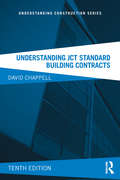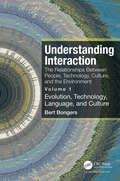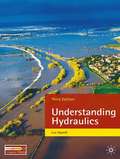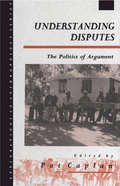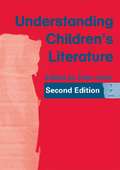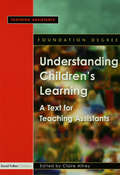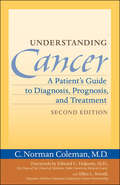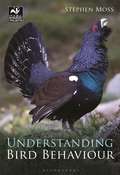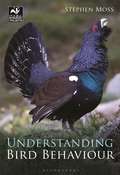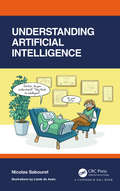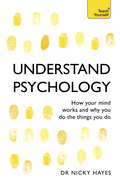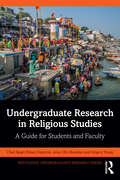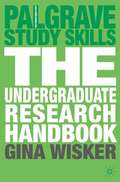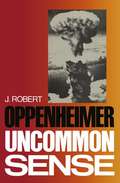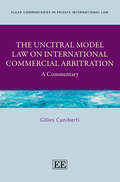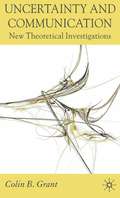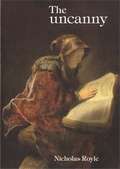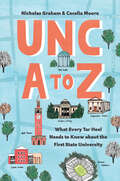- Table View
- List View
Understanding JCT Standard Building Contracts (Understanding Construction)
by David ChappellThis tenth edition of David Chappell’s bestselling guide has been revised to take into account changes made in 2016 to payment provisions, loss and/or expense, insurance and many other smaller but significant changes, and includes a section on performance bonds and guarantees. This remains the most concise guide available to the most commonly used JCT building contracts: Standard Building Contract with quantities, 2016 (SBC16), Intermediate Building Contract 2016 (IC16), Intermediate Building Contract with contractor’s design 2016 (ICD16), Minor Works Building Contract 2016 (MW16), Minor Works Building Contract with contractor’s design 2016 (MWD16) and Design and Build Contract 2016 (DB16). Chappell avoids legal jargon and writes with authority and precision. Architects, quantity surveyors, contractors and students of these professions will find this a practical and affordable reference tool arranged by topic.
Understanding Interaction: Volume 1: Evolution, Technology, Language and Culture
by Bert BongersUnderstanding Interaction explores the interaction between people and technology in the broader context of the relations between the human-made and the natural environments. It is not just about digital technologies – our computers, smartphones, the Internet – but all our technologies, such as mechanical, electrical, and electronic. Our ancestors started creating mechanical tools and shaping their environments millions of years ago, developing cultures and languages, which in turn influenced our evolution. Volume 1 looks into this deep history, starting from the tool-creating period (the longest and most influential on our physical and mental capacities) to the settlement period (agriculture, domestication, villages and cities, written language), the industrial period (science, engineering, reformation, and renaissance), and finally the communication period (mass media, digital technologies, and global networks). Volume 2 looks into humans in interaction – our physiology, anatomy, neurology, psychology, how we experience and influence the world, and how we (think we) think. From this transdisciplinary understanding, design approaches and frameworks are presented to potentially guide future developments and innovations. The aim of the book is to be a guide and inspiration for designers, artists, engineers, psychologists, media producers, social scientists, etc., and, as such, be useful for both novices and more experienced practitioners. Image Credit: Still of interactive video pattern created with a range of motion sensors in the Facets kaleidoscopic algorithm (based underwater footage of seaweed movement) by the author on 4 February 2010, for a lecture at Hyperbody at the Faculty of Architecture, TU Delft, NL.
Understanding Interaction: Volume 1: Evolution, Technology, Language and Culture
by Bert BongersUnderstanding Interaction explores the interaction between people and technology in the broader context of the relations between the human-made and the natural environments. It is not just about digital technologies – our computers, smartphones, the Internet – but all our technologies, such as mechanical, electrical, and electronic. Our ancestors started creating mechanical tools and shaping their environments millions of years ago, developing cultures and languages, which in turn influenced our evolution. Volume 1 looks into this deep history, starting from the tool-creating period (the longest and most influential on our physical and mental capacities) to the settlement period (agriculture, domestication, villages and cities, written language), the industrial period (science, engineering, reformation, and renaissance), and finally the communication period (mass media, digital technologies, and global networks). Volume 2 looks into humans in interaction – our physiology, anatomy, neurology, psychology, how we experience and influence the world, and how we (think we) think. From this transdisciplinary understanding, design approaches and frameworks are presented to potentially guide future developments and innovations. The aim of the book is to be a guide and inspiration for designers, artists, engineers, psychologists, media producers, social scientists, etc., and, as such, be useful for both novices and more experienced practitioners. Image Credit: Still of interactive video pattern created with a range of motion sensors in the Facets kaleidoscopic algorithm (based underwater footage of seaweed movement) by the author on 4 February 2010, for a lecture at Hyperbody at the Faculty of Architecture, TU Delft, NL.
Understanding Hydraulics (PDF)
by Leslie HamillCovering all the fundamental topics in hydraulics and hydrology, this text is essential reading for undergraduate students and practising engineers around the world who want an accessible, thorough and trusted introduction to the subject. By encouraging readers to work through examples, try simple experiments and continually test their own understanding as the book progresses, the text quickly builds confidence. This hands-on approach aims to show students just how interesting hydraulics and hydrology are, as well as providing an invaluable reference resource for practising engineers. Key features: an easy-to-read, engaging text a wealth of worked examples to reinforce the theory boxed highlights and Remember! features Self Test and Revision Questions with solutions a wide range of figures and photographs This third edition includes: Updates on climate change, flood risk management, flood alleviation, design considerations when developing greenfield sites, and the design of storm water sewers A new chapter on sustainable storm water management
Understanding Disputes: The Politics of Argument
by Pat CaplanAre disputes ever really resolved, or do people need to find ways of accommodating them and living with the consequences? Can dispute settlement procedures at the local level be transferred to wider environments? In attempting to answer these questions, some of the foremost specialists in the anthropology of law and disputing behaviour examine how people in a variety of social settings, ranging from Ireland to East Africa, deal with quarrels and seek to resolve or accommodate them. This stimulating volume should be of interest to anyone concerned about the increase in conflict in many parts of the world.
Understanding Disputes: The Politics of Argument (Explorations In Anthropology Ser.)
by Pat CaplanAre disputes ever really resolved, or do people need to find ways of accommodating them and living with the consequences? Can dispute settlement procedures at the local level be transferred to wider environments? In attempting to answer these questions, some of the foremost specialists in the anthropology of law and disputing behaviour examine how people in a variety of social settings, ranging from Ireland to East Africa, deal with quarrels and seek to resolve or accommodate them. This stimulating volume should be of interest to anyone concerned about the increase in conflict in many parts of the world.
Understanding Children's Literature: Key Essays From The International Companion Encyclopedia Of Children's Literature
by Peter HuntEdited by Peter Hunt, a leading figure in the field, this book introduces the study of children’s literature, addressing theoretical questions as well as the most relevant critical approaches to the discipline. The fourteen chapters draw on insights from academic disciplines ranging from cultural and literary studies to education and psychology, and include an essay on what writers for children think about their craft. The result is a fascinating array of perspectives on key topics in children’s literature as well as an introduction to such diverse concerns as literacy, ideology, stylistics, feminism, history, culture and bibliotherapy. An extensive general bibliography is complemented by lists of further reading for each chapter and a glossary defines critical and technical terms, making the book accessible for those coming to the field or to a particular approach for the first time. In this second edition there are four entirely new chapters; contributors have revisited and revised or rewritten seven of the chapters to reflect new thinking, while the remaining three are classic essays, widely acknowledged to be definitive. Understanding Children’s Literature will not only be an invaluable guide for students of literature or education, but it will also inform and enrich the practice of teachers and librarians.
Understanding Children's Literature
by Peter HuntEdited by Peter Hunt, a leading figure in the field, this book introduces the study of children’s literature, addressing theoretical questions as well as the most relevant critical approaches to the discipline. The fourteen chapters draw on insights from academic disciplines ranging from cultural and literary studies to education and psychology, and include an essay on what writers for children think about their craft. The result is a fascinating array of perspectives on key topics in children’s literature as well as an introduction to such diverse concerns as literacy, ideology, stylistics, feminism, history, culture and bibliotherapy. An extensive general bibliography is complemented by lists of further reading for each chapter and a glossary defines critical and technical terms, making the book accessible for those coming to the field or to a particular approach for the first time. In this second edition there are four entirely new chapters; contributors have revisited and revised or rewritten seven of the chapters to reflect new thinking, while the remaining three are classic essays, widely acknowledged to be definitive. Understanding Children’s Literature will not only be an invaluable guide for students of literature or education, but it will also inform and enrich the practice of teachers and librarians.
Understanding Children's Learning: A Text for Teaching Assistants
by Claire AlfreyStructured to support teaching assistants, this pioneering textbook provides an academic underpinning to each of the key topics studied. The book: develops the theoretical knowledge needed to enhance work in the classroom; encourages students to reflect on their own practice; is in an ideal textbook format - full of tasks, questions, summaries and reading lists; and covers both primary and secondary years. Practical, easy-to-read and written specifically for teaching assistants, this book is also applicable for any trainee teachers or students of education.
Understanding Children's Learning: A Text for Teaching Assistants
by Claire AlfreyStructured to support teaching assistants, this pioneering textbook provides an academic underpinning to each of the key topics studied. The book: develops the theoretical knowledge needed to enhance work in the classroom; encourages students to reflect on their own practice; is in an ideal textbook format - full of tasks, questions, summaries and reading lists; and covers both primary and secondary years. Practical, easy-to-read and written specifically for teaching assistants, this book is also applicable for any trainee teachers or students of education.
Understanding Cancer: A Patient's Guide to Diagnosis, Prognosis, and Treatment
by C. Norman ColemanThe greatest need of anyone with cancer is to understand the disease—its diagnosis, treatment options, and the often devastating experience of having cancer. In Understanding Cancer, Dr. C. Norman Coleman explains how to gather information about treatments and how to interpret that information to make decisions. He helps the person with cancer prepare for visits to doctors and the hospital and to make those visits as productive as possible. He distills the often complex medical terms and concepts underlying the statistics and percentages used to characterize medical conditions. With clear, in-depth discussions of pretreatment staging of disease, the biology of cancer, how successful treatment is defined, and how best to manage one's time, Understanding Cancer helps people with cancer and their families become active participants in the decision-making process.In the second edition of this highly respected guide, Dr. Coleman describes new treatments that target specific types of cancer as well as treatments that are designed for a particular individual. He discusses the era of molecular medicine, including biomarkers, novel imaging, molecular signatures and profiling, and molecular-targeted therapy. Many of these therapies are currently only available through a clinical trial, so Dr. Coleman includes a detailed discussion of what is involved in participating in research trials.Compassionate, accessible, and informative, Understanding Cancer will increase the reader's knowledge of medical concepts and terms so the person with cancer, the family, and the health care team can work together efficiently—and effectively.
Understanding Bird Behaviour
by Stephen MossThe way birds behave is one of the vital keys to accurate identification and this book provides the experienced instruction needed to understand and get the most out of watching birds. The guide covers all the fundamental types of bird behaviour, including movement, feeding, breeding, migration, navigation, distribution, range, life and death, all of which are illustrated with beautiful photographs. There is a whole section dedicated to the behaviour of different species groups, from divers and grebes through to sparrows, buntings and finches.
Understanding Bird Behaviour
by Stephen MossThe way birds behave is one of the vital keys to accurate identification and this book provides the experienced instruction needed to understand and get the most out of watching birds. The guide covers all the fundamental types of bird behaviour, including movement, feeding, breeding, migration, navigation, distribution, range, life and death, all of which are illustrated with beautiful photographs. There is a whole section dedicated to the behaviour of different species groups, from divers and grebes through to sparrows, buntings and finches.
Understanding Autism Spectrum Disorders: Frequently Asked Questions
by Diane YapkoThis is an essential resource for parents, teachers, those new to the field, and people on the autism spectrum. Yapko, who has worked with individuals with ASDs and their families for over 20 years, brings together information about the latest `scientific breakthroughs', current developmental theories, and practical interventions around ASD.
Understanding Artificial Intelligence
by Nicolas SabouretArtificial Intelligence (AI) fascinates, challenges and disturbs us. There are many voices in society that predict drastic changes that may come as a consequence of AI – a possible apocalypse or Eden on earth. However, only a few people truly understand what AI is, what it can do and what its limitations are. Understanding Artificial Intelligence explains, through a straightforward narrative and amusing illustrations, how AI works. It is written for a non-specialist reader, adult or adolescent, who is interested in AI but is missing the key to understanding how it works. The author demystifies the creation of the so-called "intelligent" machine and explains the different methods that are used in AI. It presents new possibilities offered by algorithms and the difficulties that researchers, engineers and users face when building and using such algorithms. Each chapter allows the reader to discover a new aspect of AI and to become fully aware of the possibilities offered by this rich field.
Understanding Artificial Intelligence
by Nicolas SabouretArtificial Intelligence (AI) fascinates, challenges and disturbs us. There are many voices in society that predict drastic changes that may come as a consequence of AI – a possible apocalypse or Eden on earth. However, only a few people truly understand what AI is, what it can do and what its limitations are. Understanding Artificial Intelligence explains, through a straightforward narrative and amusing illustrations, how AI works. It is written for a non-specialist reader, adult or adolescent, who is interested in AI but is missing the key to understanding how it works. The author demystifies the creation of the so-called "intelligent" machine and explains the different methods that are used in AI. It presents new possibilities offered by algorithms and the difficulties that researchers, engineers and users face when building and using such algorithms. Each chapter allows the reader to discover a new aspect of AI and to become fully aware of the possibilities offered by this rich field.
Understand Psychology: How Your Mind Works and Why You Do the Things You Do (Teach Yourself)
by Nicky HayesA FASCINATING INSIGHT INTO WHAT MAKES US TICKThe bestselling Understand Psychology explains basic psychological processes and how they influence us in all aspects of everyday life. It explores why we are the way we are, how we came to be that way, and what we might do to change seemingly fundamental traits. The book puts psychology in context, using non-technical language to analyze everyday situations. It is a comprehensive introduction that shows how human experience can be understood on many levels.Understand Psychology takes you through every aspect of the subject, from child development and social influences to the role of memories and emotions. You will discover how we interact with each other, why we dream, what motivates us, why children need to play and whether watching TV is bad for you.Now fully revised and updated, this 6th edition of the bestselling guide includes brand new material on mindfulness, social living, focusing in particular on shyness and loneliness and social media, coping with stress, decision making and forensic psychology, addiction and modern drugs, cognitive neuropsychology, and the psychology of learning, including teaching, exams and exam stress.The clear structure, packed full of practical examples, makes it easy to learn the essentials you really need to know.ABOUT THE SERIESPeople have been learning with Teach Yourself since 1938. With a vast range of practical, how-to guides covering language learning, lifestyle, hobbies, business, psychology and self-help, there's a Teach Yourself book for whatever you want to do. Join more than 60 million people who have reached their goals with Teach Yourself, and never stop learning.
Undergraduate Research in Religious Studies: A Guide for Students and Faculty (Routledge Undergraduate Research Series)
by Ruben Dupertuis Chad Spigel Jenny Olin Shanahan Gregory YoungUndergraduate Research in Religious Studies provides students and faculty with an invaluable guide to conducting research projects across all areas in the study of religion. With an emphasis on student-faculty collaboration, this concise book addresses the key areas, methods, and practical issues to inform the practice of original undergraduate research across a wide range of subdisciplines.In fourteen short chapters, the authors lay out the stages of the research process and different research methodologies; discuss approaches, examples, and ethical issues particular to religious studies; and address the unique value and challenges of collaborative research with undergraduate students, including case studies of student-faculty collaboration. Designed to be utilized by students and faculty as both a textbook and reference, this book offers an essential resource for all those engaging in or leading undergraduate research across religious studies.
Undergraduate Research in Religious Studies: A Guide for Students and Faculty (Routledge Undergraduate Research Series)
by Ruben Dupertuis Chad Spigel Jenny Olin Shanahan Gregory YoungUndergraduate Research in Religious Studies provides students and faculty with an invaluable guide to conducting research projects across all areas in the study of religion. With an emphasis on student-faculty collaboration, this concise book addresses the key areas, methods, and practical issues to inform the practice of original undergraduate research across a wide range of subdisciplines.In fourteen short chapters, the authors lay out the stages of the research process and different research methodologies; discuss approaches, examples, and ethical issues particular to religious studies; and address the unique value and challenges of collaborative research with undergraduate students, including case studies of student-faculty collaboration. Designed to be utilized by students and faculty as both a textbook and reference, this book offers an essential resource for all those engaging in or leading undergraduate research across religious studies.
The Undergraduate Research Handbook (PDF)
by Gina WiskerThis practical, research-informed text will provide students across all disciplines with models, tasks and activities to enable them to plan, action, write and present quality research. It will help develop ideas, creative thinking and systematic research practices to enable students to produce high quality dissertations and reports.
Uncommon Sense
by J. Robert OppenheimerJ. Robert Oppenheimer, a leading physicist in the Manhattan Project, recognized that scientific inquiry and discovery could no longer be separated from their effect on political decision-making, social responsibility, and human endeavor in general. He openly addressed issues of common concern and as a scientist accepted the responsibility brought about by nuclear physics and the atom bomb. In this collection of essays and speeches, Oppenheimer discusses the shift in scientific awareness and its impact on education, the question of openness in a society forced to keep secrets, the conflict between individual concerns and public and political necessity, the future of science and its effects on future politics---in short, the common and uncommon sense we find in our modern day reality.
The UNCITRAL Model Law on International Commercial Arbitration: A Commentary (Elgar Commentaries in Private International Law series)
by Gilles CunibertiThis Commentary provides rich and detailed analysis both of the provisions of the UNCITRAL Model Law on International Commercial Arbitration (the Model Law), and of its implementation, including a comparative account of the operation of the Model Law in the numerous jurisdictions which have adopted it throughout the world.Key Features:Comparative and thorough analysis of the provisions of the Model LawConsideration of the interpretations of the Model Law adopted by courts, with references to numerous cases from common law jurisdictions (Singapore, Hong Kong, India, Australia, New Zealand, Canada), Germany and Austria, central Europe (Poland, Hungary, Bulgaria), Spain, South Korea and EgyptInsight into variations in the statutory implementation of the Model Law in various jurisdictions across Europe, Asia, the Middle East and Latin and North America, with the most common amendments identified and highlightedDiscussion on whether the amendments adopted in Model Law jurisdictions should be persuasive in other Model Law jurisdictionsExploring how the Model Law is applied and interpreted in multiple jurisdictions, this practical and exhaustive commentary will be an essential resource for arbitrators and commercial litigators and will also appeal to scholars in the fields of arbitration, international dispute resolution, and international commercial law.
Uncertainty and Communication: New Theoretical Investigations
by Colin B. GrantSharing a commitment to the theory of communication to Habermas' Theory of Communicative Action , Grant here issues a range of challenges to it. He critiques theories of dialogism and intersubjectivity, proposes a rethinking of the communicating subject in society and explores the new contingencies of culture and media in today's world.
The Uncanny (PDF)
by Nicholas RoyleThis is the first book-length study of the uncanny, an important topic for contemporary thinking on literature, film, philosophy, psychoanalysis, feminism and queer history.
UNC A to Z: What Every Tar Heel Needs to Know about the First State University
by Nicholas Graham Cecelia MooreCovering everything from the Old Well to the Speaker Ban and more, UNC A to Z is a concise, easy-to-read introduction to the nation's first public university, the University of North Carolina at Chapel Hill. Perfect for new students getting to know the campus or alumni who want to learn more about their alma mater, this richly illustrated reference contains more than 350 entries packed with fascinating facts, interesting stories, and little-known histories of the people, places, and events that have shaped the Carolina we know today.With histories of campus buildings like Old East, gathering places like the Pit, and the many student traditions like the Cardboard Club, the Cake Race, and High Noon, UNC A to Z is the book every Tar Heel will want to keep close at hand.
